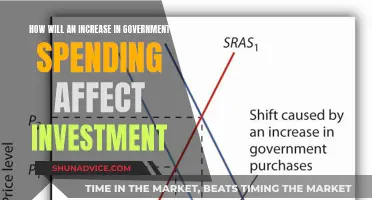
Choosing the right investment is a complex task that requires careful consideration of various factors. The first step is to understand your financial goals, investment time frame, and risk tolerance. Investments can be classified as defensive or growth investments, with defensive investments being lower-risk options that aim to provide income and protect capital, and growth investments offering higher potential returns but carrying more risk. It's important to diversify your investments to reduce risk and maximise returns. When choosing an investment, it's crucial to research and understand how it works, its potential returns, associated risks, fees, and how it aligns with your financial goals.
| Characteristics | Values |
|---|---|
| Investment type | Defensive or growth |
| Investment goals | Financial goals, time frame, risk tolerance |
| Risk | Low, medium, high |
| Returns | Capital gain or income |
| Time frame | Short-term (0-5 years), long-term (5+ years) |
| Diversification | Spread money across different types of investments |
| Investor type | Hands-on or hands-off |
| Fees | Management fees, administration fees, entry and exit fees |
| Taxes | Tax implications of the investment |
What You'll Learn

Evaluate your risk tolerance
When it comes to investing, it's important to evaluate your risk tolerance, or how much risk you're willing to take on. All investments involve some degree of risk, and understanding your risk tolerance will help you choose the right investments for your portfolio. Here are some things to consider when evaluating your risk tolerance:
Investment Goals and Time Horizon
The time horizon for your investments is crucial when determining your risk tolerance. If you have long-term financial goals, you may be able to take on more risk, as you have more time to recover from any potential losses. Conversely, if you have short-term goals, you may want to opt for more conservative, lower-risk investments.
Age and Income
Your age and income can also play a role in your risk tolerance. Generally, younger investors with a longer time horizon are considered more risk-tolerant and may be more inclined to invest in stocks and stock funds. However, it's important to note that age is not the sole determining factor, and older investors with a higher net worth and more liquid capital may also have a higher risk tolerance.
Investment Experience
Your level of investment experience is another factor to consider. If you're new to investing, it's generally advisable to proceed with caution and gain some experience before taking on more risk.
Risk Capital and Net Worth
Your net worth and available risk capital are important considerations. If you have a high net worth, you may be able to assume more risk, as a potential loss will constitute a smaller percentage of your overall worth. Conversely, those with limited risk capital may be drawn to riskier investments due to the lure of quick and large profits, but this can be a dangerous strategy.
Investment Objectives
Understanding your investment objectives is crucial when determining your risk tolerance. If you are investing for a child's education or your retirement, you may want to be more conservative. On the other hand, if you are investing with disposable income or true risk capital, you may be more comfortable taking on higher-risk investments.
Risk Tolerance Assessments
To help you assess your risk tolerance, many investment websites offer free online questionnaires and surveys. While these can provide a starting point, keep in mind that the results may be biased towards the financial products or services sold by the sponsoring companies or individuals.
By considering these factors, you can gain a better understanding of your risk tolerance and make more informed investment decisions. Remember, investing always carries some level of risk, and it's important to carefully evaluate your personal financial situation, goals, and comfort level with risk before proceeding.
Young People: Invest Now, Gain Later
You may want to see also

Understand different types of investments
Understanding the different types of investments is crucial for choosing the right investment strategy. Investments can be broadly classified into defensive and growth investments, each offering varying levels of risk, return potential, and investment timeframes.
Defensive investments are lower-risk options that aim to provide income and protect the invested capital. Examples include cash and fixed-interest investments, such as bank accounts, high-interest savings accounts, and term deposits, as well as government and corporate bonds. These investments are suitable for short-term financial goals, typically within a timeframe of up to three years. They offer very low to low risk and provide stable returns, usually averaging around 3-4% per year over the last decade.
On the other hand, growth investments carry higher risk and offer higher potential returns. They include shares, property, and alternative investments. These investments are suitable for long-term financial goals, typically with a timeframe of five years or more. They can provide steady income through rent or dividends and offer capital growth. However, their prices can be volatile over short periods. The average return over the last decade for residential and commercial property has been around 6.3% per year.
Alternative investments are another category that includes private equity, infrastructure, commodities, and other unique investments. These are typically high-risk options and may provide steady income or capital growth.
It is important to note that different types of assets have different levels of risk. To manage risk effectively, investors should consider diversifying their portfolios by investing in a mix of different asset classes. This helps to reduce the impact of short-term fluctuations and potential losses by spreading the investment across various companies, industries, and regions.
Additionally, when choosing an investment, it is crucial to understand your financial goals, risk tolerance, and investment timeframe. These factors will influence the types of investments you choose and the level of risk you are comfortable with.
Investment Scams: Why the Fall?
You may want to see also

Diversify your portfolio
Diversifying your portfolio is a crucial aspect of investment strategy. Here are some detailed tips to help you diversify your portfolio effectively:
Spread the Wealth
Diversification is about not putting all your eggs in one basket. It's a warning against investing all your money in a single stock, sector, or asset class. To achieve diversification, look for asset classes with low or negative correlations. This means that if one type of investment decreases in value, the other tends to counteract it and increase in value. For example, you could invest in a mix of stocks, bonds, and real estate.
Consider Index Funds or Bond Funds
Index funds are a great way to achieve instant diversification. For example, investing in an S&P 500 index fund gives you exposure to 500 of the largest US public companies. Index funds also tend to have low fees, as there is no fund manager actively researching and hand-picking investments. While index funds are passively managed, which can be suboptimal in inefficient markets, they are a good option for long-term diversification.
Keep Building Your Portfolio
Regularly add to your investments using a strategy called dollar-cost averaging. This strategy involves investing the same amount of money over a period of time, buying more shares when prices are low and fewer when prices are high. This helps to smooth out the peaks and valleys of market volatility and reduce your overall investment risk.
Know When to Get Out
While buying and holding, and dollar-cost averaging are sound strategies, it's important to stay informed about your investments and overall market conditions. Keep an eye on the companies you invest in, so you know when it's time to cut your losses and sell.
Keep an Eye on Commissions
Be aware of the fees you are paying, whether they are monthly or transactional. While some online brokers now offer commission-free trading in certain stocks and ETFs, trading mutual funds, illiquid stocks, and alternative asset classes often comes with a fee.
Other Tips
- Number of Investments: Try to limit yourself to a manageable number of investments. Having too many investments can be difficult to keep track of and may not be worth the time and resources. A good rule of thumb is to invest in around 20 to 30 different vehicles.
- Non-Correlated Investments: Consider investing in non-stock options whose prices don't move in line with stock market indexes, such as bonds, bank certificates of deposit (CDs), gold, cryptocurrencies, and real estate.
- Number of Stocks: A good rule of thumb is to own at least 25 stocks from various industries. This ensures you are not too heavily invested in one sector, which could lead to significant losses if that industry declines.
- Fixed Income: Investing in fixed-income assets like bonds can reduce your portfolio's overall risk and volatility, although it may also lower your potential returns.
- Real Estate: Adding real estate to your portfolio can increase total returns while reducing volatility. An easy way to invest in real estate is through real estate investment trusts (REITs), which own income-producing commercial properties.
Remember, diversification is a key part of successful investing. By diversifying your portfolio, you can reduce your risk and potentially increase your returns over time.
Fisher Investments: Happy Customers?
You may want to see also

Consider your investment timeline
When choosing an investment, it's important to consider your investment timeline. This will help you decide the type of investment vehicle to consider, which investments to avoid, and how long to hold your investment.
If you are investing with a short-term timeline, you will want to take a less risky approach to protect yourself from significant short-term losses. Generally, short-term investments are those with a timeline of less than five years. Holding funds in cash or liquid vehicles is likely the most appropriate strategy. Money market funds, savings accounts, and short-term certificates of deposit are popular conservative investments.
For intermediate-term goals, which are those five to 10 years in the future, you can afford to take on a little more risk. Some exposure to stocks and bonds will help grow the initial investment's value, and there is enough time to recover from any short-term losses. Balanced mutual funds, which include a mix of stocks and bonds, are popular investments for intermediate-term goals.
Long-term investments, on the other hand, are those with a timeline of more than 10 years. Over long periods, stocks offer greater potential rewards, and there is often sufficient time to recover from market fluctuations. However, volatility is often a greater risk in the short term than in the long term. Therefore, investors often choose aggressive investment vehicles, such as growth stocks, as part of a long-term investment plan.
It's also important to note that your investment timeline may depend on your age and goals, as well as current regulations. For example, the SECURE 2.0 Act of 2022 defined the age for required minimum distributions (RMDs) from a retirement account as 73, increasing to 75 in 2033.
When considering your investment timeline, it's crucial to evaluate your risk tolerance and investment objectives. Are you willing and able to take on investment risk? Do you need capital preservation or can you put your capital at risk for a higher return? Understanding these factors will help you choose the right investments to meet your financial goals.
Investment Strategies: How to Choose?
You may want to see also

Research and seek advice
Researching and seeking advice are crucial steps in choosing the right investment. Here are some detailed instructions to help you navigate these steps effectively:
- Understand your financial situation: Before investing, take an honest look at your entire financial situation. Consider your income, expenses, savings, and financial goals. This will help you determine how much money you can comfortably invest and which investments align with your goals.
- Evaluate your risk tolerance: All investments carry some risk, and it's important to assess how much risk you are comfortable taking on. Consider your financial goals, investment horizon, and personal risk tolerance. Remember that higher-risk investments, such as stocks, typically offer higher potential returns but also come with a greater possibility of loss.
- Conduct thorough research: Before investing, research and understand the investment inside out. Study how the investment works, its historical performance, expected returns, associated risks, fees, and legal and tax implications. This information is typically available in product disclosure statements or similar documents.
- Diversify your investments: Diversification is a key risk management strategy. Spread your investments across different asset classes, industries, and geographic regions. By doing so, you reduce the impact of any single investment on your portfolio and increase your potential for long-term gains.
- Seek professional advice: Consider consulting a financial adviser or investment manager, especially if you are new to investing. They can provide personalised guidance based on your financial situation, goals, and risk tolerance. They can also help you navigate the complexities of different investment options and strategies.
- Stay informed and educated: Investing is a continuous learning process. Stay updated on market trends, economic conditions, and investment strategies. Read books, follow reputable financial websites and publications, and consider subscribing to financial newsletters. The more knowledge you have, the better your investment decisions will be.
- Monitor your investments regularly: Regularly review the performance of your investments. Stay informed about any news or developments related to your investments. Monitoring helps you identify areas that may require adjustments and ensures you stay on track to meet your financial goals.
- Understand investment scams and fraud: Unfortunately, scams and fraud are prevalent in the investment world. Educate yourself about common investment scams and how to spot them. Always be cautious and verify the legitimacy of any investment opportunity before committing your money.
Smart Ways to Invest $1,000 Right Now
You may want to see also
Frequently asked questions
Before making an investment, it is important to consider your financial goals, investment time frame, and risk tolerance. You should also understand how the investment works, how it generates returns, the associated risks, fees, legal and tax implications, and how it will contribute to your diversified portfolio.
Defensive investments are lower-risk investments that aim to provide income and protect the capital invested. They are typically used for short-term financial goals (up to two years) and include cash and fixed-interest investments such as bank accounts, high-interest savings accounts, and government bonds. On the other hand, growth investments are higher-risk and offer higher potential returns. They aim to provide capital growth and may provide income through dividends or rent. Growth investments include shares, property, and alternative investments.
The right type of investment depends on your investment goals, time horizon, and risk tolerance. If you are investing for the long term, you may consider investing in riskier assets as you have more time to ride out market volatility. Diversification is also key—spreading your investments across different companies, industries, and asset classes can help reduce the risk of losses.
Asset allocation involves dividing your investment capital among different asset classes, such as stocks, bonds, and cash. By investing in multiple asset classes, you can reduce the risk of significant losses as they tend to perform differently under various market conditions. A well-diversified portfolio can help protect your investments and smoothen out returns over time.
Investing carries several risks, including market risk, inflation risk, interest rate risk, liquidity risk, and sequencing risk. Market risk refers to the potential loss due to movements in financial markets. Inflation risk is the possibility that your investment returns won't grow above inflation, affecting your long-term purchasing power. Interest rate risk is the potential for losses due to changes in interest rates. Liquidity risk is the chance that you won't be able to sell your investment when needed or that you'll have to sell it at a loss. Sequencing risk is relevant for retirees, as negative returns early in retirement can significantly impact the longevity of retirement savings.







